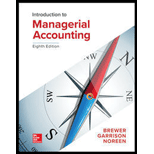
Concept explainers
Schedules of Expected Cash Collections and Disbursements; Income Statement: Balance Sheet LOB-2. L08-4, LOB-9, LOB—10
Refer to the data for Beech Corporation in Exercise 8-12 .The Company is considering making the following changes to the assumptions underlying its
1. Each month’s credit sales are collected 45% in the month of sale and 55%in the month following the sale.
2. Each month’s ending inventory must equal 20% of the cost of nextmonth’s sales.
3. Thecompany pays for 30% of its merchandise purchases in the month of the purchase and the reaming 70% us the month following the purchase.
All other information from Exercise 8-12 that is not mentioned above remains the same.
Required:
Using the new assumptions described above, complete the following requirements:
1. Prepare a schedule of expected cash collections for July. August, and September, Also compute total cash collections for the quarter ended September 30.
2. a. Prepare a merchandise purchases budget for July. August, and September Also compute total merchandise purchases for the quarter ended September30.
b. Prepare a schedule of expected cash disbursements for merchandise purchases for July. August and September Also compute total cash disbursementsfor merchandise purchases for the quarter ended September 30.
3. Using Schedule 9 as your guide, prepare an income statement for the quarter ended September 30.
4. Prepare a balance sheet as of September 30.
1.
the value of the collection in the month of July, August, September and October
Introduction: Budget is the evaluation of the revenue and the expense which is expected incur in the specified period.
Explanation of Solution
Total cash collection of the July August, September and December are $230,500, 219,000, 225,500 and $229,000.
Calculate the expected cash collection,
| Particulars | July | August | September | October |
| Sales | 210,000 | 230,000 | 220,000 | 240,000 |
| Collection | ||||
| 45% in month of sales | 94,500 | 103,500 | 99,000 | 108,000 |
| 55% in the month of following | 0 | 115,500 | 126,500 | 121,000 |
| Collection from account receivable | 136,000 | 0 | 0 | 0 |
| Total cash collection | 230,500 | 219,000 | 225,500 | 229,000 |
2.
the value of the merchandise purchase for the quarter ended September
Introduction: Budget is the evaluation of the revenue and the expense which is expected incur in the specified period.
Explanation of Solution
Formula to calculate the merchandise purchase for the quarter ended September,
Substitute, $27,600 for the closing inventory July, $26,400 for the closing inventory of August and $28,800 for the September
Working notes:
Calculation of merchandise purchase budget
| Particulars | July | August | September | October |
| Sales | 210,000 | 230,000 | 220,000 | 240,000 |
| Cost of goods sold (60%) | 126,000 | 138,000 | 132,000 | 144,000 |
| Less: Opening inventory | 62,000 | 27,600 | 26,400 | |
| Add: closing inventory(20% of the next month cost of goods sold) | 27,600 | 26,400 | 28,800 | |
b.
The value of the merchandise purchases
Introduction: Budget is the evaluation of the revenue and the expense which is expected incur in the specified period.
Explanation of Solution
Formula to calculate total cash disbursement for merchandise purchase for the quarter ended September,
Substitute, $113,200 for merchandise purchase in month July, $117,200for merchandise purchase in month of August and $135,800 for merchandise purchase in month September
Working notes:
| Particulars | July | August | September |
| Purchases | 91,600 | 136,800 | 134,400 |
| Cash payment (30%) | $27,480 | $41,040 | $40,320 |
| 70% on the following month | 0 | 64,120 | 95,760 |
| Payment of account payable in month of July | 71,100 | 0 | 0 |
| Total | 98,580 | 105,160 | 136,080 |
Calculate the purchase in the month of July,
Calculate the purchase in the month of August,
Calculate the purchase in the month of September,
3.
To prepare: Income statement of the company
Introduction: Budget is the evaluation of the revenue and the expense which is expected incur in the specified period.
Explanation of Solution
| Particulars | JulyAmount ($) | AugustAmount ($) | September Amount ($) |
| Sales | 210,000 | 230,000 | 220,000 |
| Cost of goods sold (60%) | 126,000 | 138,000 | 132,000 |
| Gross profit | 84,000 | 92,000 | 88,000 |
| Less: Selling & Administration expense | (60,000) | (60,000) | (60,000) |
| Less: Depreciation | (5,000) | (5,000) | (5,000) |
| Less: remaining expense | (55,000) | (55,000) | (55,000) |
| Net profit(loss) | (36,000) | (28,000) | (32,000) |
4.
To Prepare: Balance sheet of the company
Introduction: Budget is the evaluation of the revenue and the expense which is expected incur in the specified period.
Explanation of Solution
| Balance sheetas on September 31 | |
| Assets: | Amount
($) |
| Cash | 225,500 |
| Account receivable | 121,000 |
| Inventory | 62,000 |
| Plant and equipment, net of depreciation | 132,000 |
| Total assets | 540,500 |
| Liability and stockholder’ equity | |
| Account payable | 209,600 |
| Common stock | 327,000 |
| Retained earnings | 3,900 |
| Total liabilities and stockholder’s equity | 563,500 |
Working notes:
Calculate the retained earnings,
Want to see more full solutions like this?
Chapter 8 Solutions
Introduction To Managerial Accounting
- What is the effect of a debit to an expense account?A. Decreases expensesB. Increases equityC. Increases expensesD. Decreases assets helparrow_forwardNo chatgpt What is the effect of a debit to an expense account?A. Decreases expensesB. Increases equityC. Increases expensesD. Decreases assetsarrow_forwardWhat is the effect of a debit to an expense account?A. Decreases expensesB. Increases equityC. Increases expensesD. Decreases assetsneed helparrow_forward
- What is the effect of a debit to an expense account?A. Decreases expensesB. Increases equityC. Increases expensesD. Decreases assetsarrow_forwardNo AI 4. If total debits exceed total credits on a trial balance, the difference is most likely:A. A net lossB. A recording errorC. A net incomeD. An overstatement of assetsarrow_forwardNeed help ! 4. If total debits exceed total credits on a trial balance, the difference is most likely:A. A net lossB. A recording errorC. A net incomeD. An overstatement of assetsarrow_forward
- 4. If total debits exceed total credits on a trial balance, the difference is most likely:A. A net lossB. A recording errorC. A net incomeD. An overstatement of assetsarrow_forwardCalculate the times-interest-earned ratios for PEPSI CO, Given the following informationarrow_forwardCalculate the times-interest-earned ratios for Coca Cola in 2020. Explain if the times-interest-earned ratios is adequate? Is the times-interest-earned ratio greater than or less than 2.5? What does that mean for the companies' income? Can the company afford the interest expense on a new loan?arrow_forward
- Which of the following is a temporary account?A. EquipmentB. Accounts PayableC. Utilities ExpenseD. Common Stockarrow_forwardUnearned revenue becomes revenue when:A. A sale is madeB. Cash is receivedC. The service is performedD. The revenue is recordedarrow_forwardWhat is the effect of a debit to an expense account?A. Decreases expensesB. Increases equityC. Increases expensesD. Decreases assetsarrow_forward
 Excel Applications for Accounting PrinciplesAccountingISBN:9781111581565Author:Gaylord N. SmithPublisher:Cengage LearningPrinciples of Accounting Volume 2AccountingISBN:9781947172609Author:OpenStaxPublisher:OpenStax College
Excel Applications for Accounting PrinciplesAccountingISBN:9781111581565Author:Gaylord N. SmithPublisher:Cengage LearningPrinciples of Accounting Volume 2AccountingISBN:9781947172609Author:OpenStaxPublisher:OpenStax College Survey of Accounting (Accounting I)AccountingISBN:9781305961883Author:Carl WarrenPublisher:Cengage Learning
Survey of Accounting (Accounting I)AccountingISBN:9781305961883Author:Carl WarrenPublisher:Cengage Learning Cornerstones of Cost Management (Cornerstones Ser...AccountingISBN:9781305970663Author:Don R. Hansen, Maryanne M. MowenPublisher:Cengage Learning
Cornerstones of Cost Management (Cornerstones Ser...AccountingISBN:9781305970663Author:Don R. Hansen, Maryanne M. MowenPublisher:Cengage Learning Managerial AccountingAccountingISBN:9781337912020Author:Carl Warren, Ph.d. Cma William B. TaylerPublisher:South-Western College Pub
Managerial AccountingAccountingISBN:9781337912020Author:Carl Warren, Ph.d. Cma William B. TaylerPublisher:South-Western College Pub Financial And Managerial AccountingAccountingISBN:9781337902663Author:WARREN, Carl S.Publisher:Cengage Learning,
Financial And Managerial AccountingAccountingISBN:9781337902663Author:WARREN, Carl S.Publisher:Cengage Learning,





